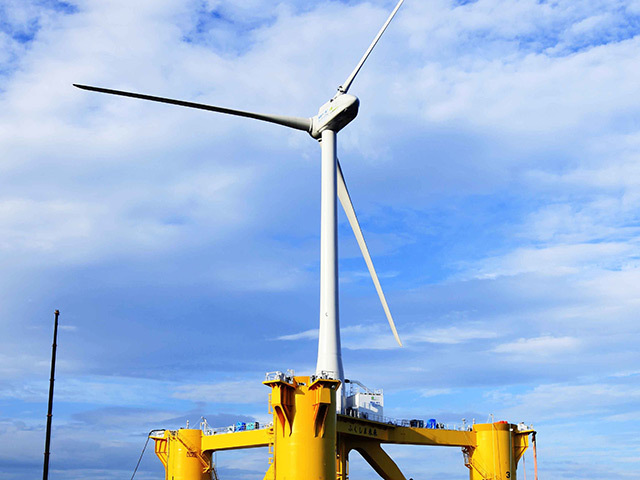
Japan has trounced the UK by developing and building a pontoon-based floating wind turbine that will start generating trials this month.
The device has been installed 17km off the coast of Fukushima; seaward of the nuclear power complex swamped by the tsunami of 2011.
It’s a modest start, but when this turbine starts its trials it will generate enough to power 1,700 homes.
And the Japanese are planning a floater-based windfarm capable of generating 1,000MW (megawatts) by 2020.
It has not escaped the New York Times that this is equivalent to the power generated by a nuclear reactor; but it will be clean, green energy untainted by the dreadful fuel legacy issue that the current and lunatic UK Government ignores.
In a nutshell, the Japanese have a home-grown maritime wind turbine. They have joined a very exclusive club and stand alongside founder member Norway, which has Hywind, and the US.
We have NOTHING.
That’s not for the want of trying by some or a lack of intellectual and engineering capacity. It’s just the way Britain is. Read Dick Winchester’s column on pages 8-9 for further insight into the current and shocking mess.
The Japanese government is footing the 22billion yen, or £140million ($226million), cost of building the first three wind turbines off Fukushima; part of prime minister Shinzo Abe’s plan to ensure that renewable energy becomes a pillar of his economic growth strategy.
Assuming that the trials are a success there is already a consortium of 11 companies, including Hitachi, Mitsubishi Heavy Industries, Shimizu and Marubeni ready to commercialise the concept. Almost the entire project to date and into the future is Japanese. Yes, 100%. No grubbing around like Britain does to draw in foreign companies’ interest because of a lack of capability, or will, or money, or drive, or government that gets the message.
It is said that harnessing wind in deeper waters off Japan could generate as much as 1,570GW (gigawatts) of electricity, roughly eight times the current capacity of all of Japan’s power companies combined, according to researchers at Tokyo University, which is one of the pilot project’s main participants.
“We’re opening a new page in the history of offshore wind power,” Takeshi Ishihara, a civil engineering expert at Tokyo University and the leader of the project, told the NYT.
Pardon me. Weren’t we, the Brits, going to do that? The leaders? The nation with the nous (other than the Norwegians of course . . . and they already have us beat).
Of course, the Japanese are going to make mistakes with the pilot project and it’s expensive. But that is the nature of pioneering trialling centres such as the European Offshore Wind Deployment Centre which remains thwarted by a self-interested selfish American gentleman and a questionable planning decision.
So how dismally far have the Brits got? The story goes roughly like this. Basically, the best we’ve been able to do so far is for the Energy Technologies Institute (ETI) saying in late 2011 that it was prepared to invest up to £25million in an offshore wind floater demonstrator that would open up new areas off the coast of the UK and help bring generation costs down.
That decision came four years after dim-wits sank a similar proposal tabled by Scotland’s Intermediary Technology Institute for Energy.
The ITIE was part of a Scottish Enterprise initiative to create three sector-specific institutes.
All three have since been consigned to Scotland’s economic development wheelie bin as they were done away with, having failed to get anywhere much. Some £450million of public money spread across 10 years was originally committed to the three ITIs.
ITIE began mapping its envisioned floating turbine programme in 2004. The idea of a floater was covered exclusively by Energy in late 2006.
ITIE’s plan was to commit up to £15million of core funding in a number of sub-programmes. It envisaged leveraging an additional £10-20million of public money though various sources. Ultimately, it failed to win favour with the ITI board (aka Scottish Enterprise).
And that was that! The proposal was dead in the water. A lack of vision at board level killed a bold ambition with deadly ease.
At least the ETI’s project is moving forward and will see the design, construction and installation of a floating system demonstrator by 2016 at a relatively near shore site with high wind speeds up to about 10m per second in water between 60 and 100m deep.
A site to the north of the tip of Cornwall has been chosen and application for consent submitted. Moreover, the turbine choice has also been made. Guess what? It’s foreign as the Brits have nothing to offer. It’s French . . . a 6MW turbine design being developed by Alstom Power. It will be operated for at least two years (optioned a further eight) to show it can generate high levels of electricity, be maintained without using specially designed vessels (really?) and to verify the predicted technical and economic performance.
France too is keen to corner a chunk of the potential wind floaters market. This is being led by the Energies Nouvelles unit of IFP, the French Institute of Petroleum.
France has a huge coastline and therefore extensive aquatory. However, its continental shelf is very narrow and this severely limits options for using conventional monopole and jacket-mounted turbines, which is why floaters are now being investigated.
Recommended for you
